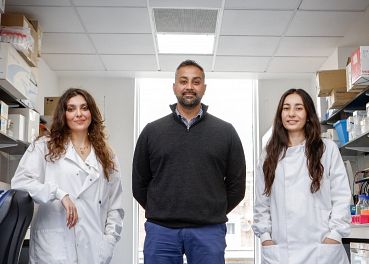Principal Investigator | Dr Vish Patel
Dr. Merianne Mohammed
Marilena Stamouli
Cirrhosis of the liver can be complicated by decompensating features, which portend worsening survival. These include the development of jaundice, synthetic failure with coagulopathy and hypoalbuminaemia, and portal hypertension leading to ascites, variceal haemorrhage, and/or hepatic encephalopathy. The causes for decompensation that lead to advanced chronic liver disease (ACLD) and the development of superimposed organ failure – termed acute-on-chronic liver failure (ACLF) – are related to pathological changes that occur affecting the ‘gut-liver axis’ in cirrhosis. ACLF causes very high short-term mortality (up to 65% at 28 days) and is thought to be triggered by undiagnosed infections in the majority of cases.
The liver is intimately linked anatomically to the gut via the portal vein, and exposure to the gut microbiota (bacteria, fungi, viruses, etc) and their metabolites translocating across the gut lumen will impact upon the diseased liver, and further drive hepatic dysfunction and even enhance fibrosis progression. Several mechanisms are likely to conspire together as key elements in the pathogenesis of ACLD. Amongst these are (i) translocation of intestinal bacteria and their products including pathogen associated molecular patterns (PAMPs), (ii) gut barrier disruption and inflammation and (iii) local gut-specific, (iv) hepatic and (v) systemic innate and adaptive immune pathway dysfunction with (vi) paradoxical systemic inflammation which in part is due to the production of danger-associated molecular patterns (DAMPs) which are endogenous inducers released by necrotic cells or as a result of extracellular matrix breakdown.
The group is focused on several work-streams focused on the gut-liver axis in ACLD:
1. Characterising the changes that occur in the oral and gut micro-/mycobiome in ACLD by metagenomic sequencing
2. Utilise novel markers to measure gut-derived bacterial translocation
3. Assess the intestinal barrier in cirrhosis (inflammatory and immune characterisation)
4. Profiling of microbiome generated metabolites e.g. plasma and faecal bile acids and by urinary NMR (working with Dr Jane Cox)
Antimicrobial resistance in Advanced Chronic Liver Disease
Worldwide, the most serious concern associated with antibiotic use is development of antimicrobial resistance (AMR), causing around 700,000 deaths annually. The last new class of antibiotics was approved in the early 1980s. The last new class of antibiotics against the deadliest Gram-negative bacteria was discovered in 1962. Multi-drug resistant organisms (MDRO) are defined as resistant to three or more antibiotic classes including β-lactams.
Bacterial infections are very common in patients with cirrhosis and are one of the most important causes of liver-related complications, progression of liver failure and to ACLF, and mortality in these patients. MDRO have emerged as a significant threat in many countries, and infections caused by these bacteria, many of which are resident within the gut, are associated with a particularly poor prognosis in patients with cirrhosis. The global prevalence of MDRO-related infections in cirrhosis has recently been reported to be as high as affecting a third of all patients, and now represents a very significant challenge in patient management. A difficulty in diagnosing infections and ensuring the correct antibiotic regimen is used remains problematic. Traditional clinical culture-based techniques take 24-48 hours to report, and delays of even a few hours in starting broad-spectrum – but possibly ineffective – treatment has been shown to increase infection-related mortality in ACLD. Accordingly, my group is focused on the following areas evaluating AMR in cirrhosis, which are absolutely key to improving outcomes:
- Defining the rate of AMR in ACLD,
- Investigating the mechanisms that predispose to developing MDROs, and
- Assessing more rapid molecular-based diagnostic testing;
- Evaluating non-antibiotic based gut-targeting therapies in reducing the rate of MDRO carriage in the gut.

